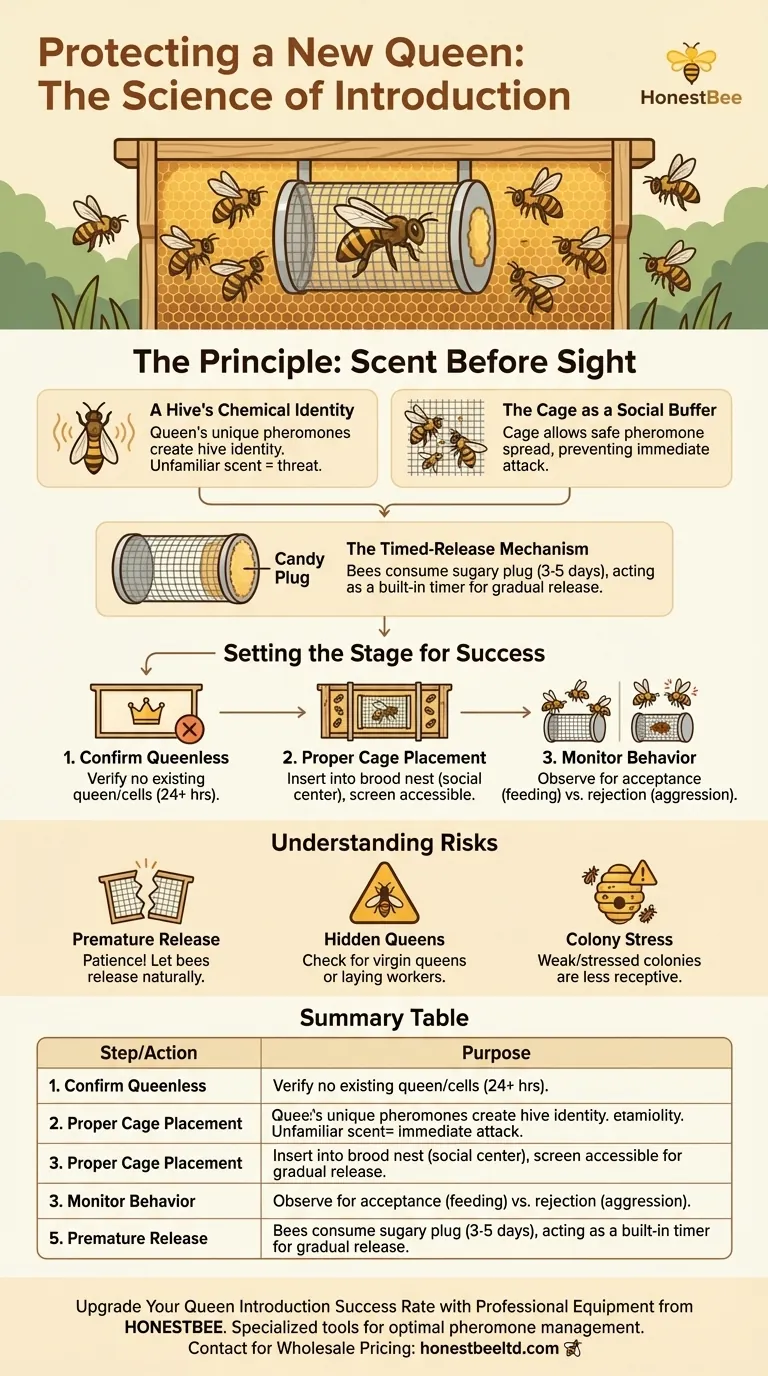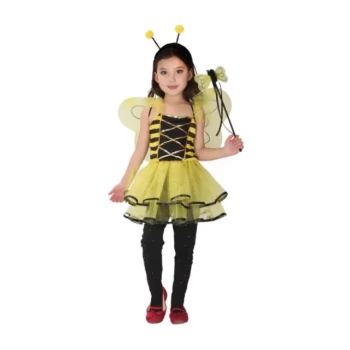To protect a new queen, beekeepers introduce her to the hive inside a small cage. This physical barrier shields her from the worker bees, who would otherwise identify her as a foreign intruder and kill her. The cage allows the queen's unique scent, or pheromones, to spread throughout the colony over several days, giving the hive time to gradually accept her as their new leader before she is released.
The core challenge of introducing a queen isn't physical, but social. The introduction cage is a tool to manage the hive's chemistry and behavior, creating a slow, controlled acclimation period that convinces the colony to accept her before she is physically released among them.

The Principle: Scent Before Sight
A honeybee colony's cohesion and identity are centered around its queen. Her specific pheromones signal to every bee that the hive is healthy and "queenright."
A Hive's Chemical Identity
Every queen produces a unique blend of pheromones, which acts as her chemical signature. Worker bees constantly spread this scent throughout the hive by grooming the queen and interacting with one another.
An unfamiliar scent is an immediate signal of a threat, triggering a defensive response.
The Cage as a Social Buffer
The introduction cage, typically a small box with one mesh side, allows the worker bees to get close to the new queen. They can touch her with their antennae and feed her through the screen.
This close, but protected, contact exposes the colony to her new pheromones without triggering an attack. Over a few days, her scent replaces that of the old queen, and the hive's chemical identity begins to shift.
The Timed-Release Mechanism
Most queen cages are equipped with a "candy plug"—a channel blocked with a sugary fondant. The cage is installed with this plug in place.
The worker bees on both sides of the cage begin to eat the candy. This process typically takes three to five days, providing a built-in timer for the queen's release. By the time the candy is gone, the hive has usually accepted her scent and will welcome her when she walks out.
Setting the Stage for a Successful Introduction
Proper preparation and observation are just as critical as the cage itself. Simply dropping a caged queen into a hive is not enough.
Confirm the Hive is Queenless
The most critical first step is to be absolutely certain the hive is queenless. A colony will never accept a new queen if they already have one, even if she is old or failing.
Before introducing the new queen, you must verify there is no existing queen and no queen cells, which would indicate the bees are already raising their own replacement.
Proper Cage Placement and Orientation
The cage should be placed in the heart of the brood nest—the area where baby bees are raised. This is the social center of the hive.
Gently press the cage between the top bars of two frames, screen-side down or sideways, so the worker bees have full access to tend to the queen through the mesh.
Monitor the Hive's Reaction
The behavior of the bees on the cage is your best indicator of acceptance. In the first day or two, you may see some bees acting aggressively, trying to sting or bite the cage. This is known as "balling" and is a sign of rejection.
After a few days, you should see a change. The workers will be calmly walking on the cage and may appear to be feeding her through the screen. This is a clear sign of acceptance.
Understanding the Trade-offs and Risks
Even with perfect procedure, queen introduction can fail. Understanding why is key to troubleshooting problems.
The Danger of a Premature Release
The most common mistake is impatience. Manually releasing the queen before the bees have fully accepted her scent will almost certainly result in her death. Always trust the process and let the bees release her by consuming the candy plug.
Hidden Queens or Laying Workers
If a new queen is repeatedly rejected, it often means the hive was not truly queenless. There might be a hidden, undiscovered virgin queen or, in long-queenless colonies, worker bees that have started laying unfertilized eggs. The colony will not accept a new queen until these issues are resolved.
Overall Colony Stress
A weak colony struggling with pests, disease, or a lack of food is less likely to accept a new queen. A strong, healthy, and well-fed hive is in a much better "mood" and will be far more receptive to change.
Making the Right Choice for Your Hive
Your approach should be guided by careful observation of the colony's specific state and needs.
- If your primary focus is the highest chance of success: Always confirm the hive is queenless for at least 24 hours and allow the bees to release the queen naturally by eating through the candy plug.
- If you are dealing with a defensive or agitated hive: Provide supplemental sugar syrup to simulate a nectar flow, which improves the colony's general temperament and increases acceptance rates.
- If you discover the queen has been rejected after release: Do not immediately add another queen. First, you must perform a thorough inspection to diagnose the reason for failure, such as finding and removing a rival virgin queen.
Ultimately, successfully introducing a new queen is a testament to the beekeeper's understanding of bee biology and social dynamics.
Summary Table:
| Step | Key Action | Purpose |
|---|---|---|
| 1 | Use a Queen Introduction Cage | Provides a physical barrier for safety while allowing scent exchange |
| 2 | Confirm Hive is Queenless | Prevents rejection by ensuring no existing queen is present |
| 3 | Place Cage in Brood Nest | Positions queen in the social center of the hive for maximum exposure |
| 4 | Monitor Worker Bee Behavior | Assesses acceptance through feeding and calm interaction vs. aggression |
| 5 | Allow Natural Release via Candy Plug | Gives hive 3-5 days to fully accept the new queen's pheromones |
Upgrade Your Queen Introduction Success Rate with Professional Equipment from HONESTBEE
Are you a commercial apiary or beekeeping equipment distributor looking to improve your queen acceptance rates and hive productivity? At HONESTBEE, we specialize in wholesale-focused operations that provide beekeepers with the reliable supplies and equipment needed for successful hive management.
Our high-quality queen introduction cages and beekeeping tools are designed specifically to support the delicate process of pheromone management and colony integration. By using equipment engineered for optimal scent diffusion and bee behavior observation, you can significantly increase your success rates and reduce costly queen losses.
Let us help you protect your most valuable asset—your queen bees.
Contact HONESTBEE today to discuss wholesale pricing and how our equipment can enhance your beekeeping operations.
Visual Guide

Related Products
- Wood and Mesh Push-In Queen Cage
- No Grafting Queen Rearing Kit: System for Royal Jelly Production and Queen Rearing
- Plastic Chinese Queen Grafting Tool for Bee Queen Rearing
- Brown Nicot Queen Cell Cups for Breeding Queen Bees Beekeeping
- JZBZ Push-In Queen Cell Cups for Beekeeping
People Also Ask
- What is sequestration, and how does it help bees reorient? A Safer Guide to Hive Relocation
- What is a push-in queen cage and how does it differ from standard cages? Achieve Higher Queen Acceptance Rates
- Why might bees reject a new queen? A Guide to Successful Queen Introduction
- How does a push-in cage improve queen introduction success? Boost Acceptance with Active Queen Demonstration
- What is requeening and how does it differ from adding a queen? Proactive vs. Reactive Hive Management



















